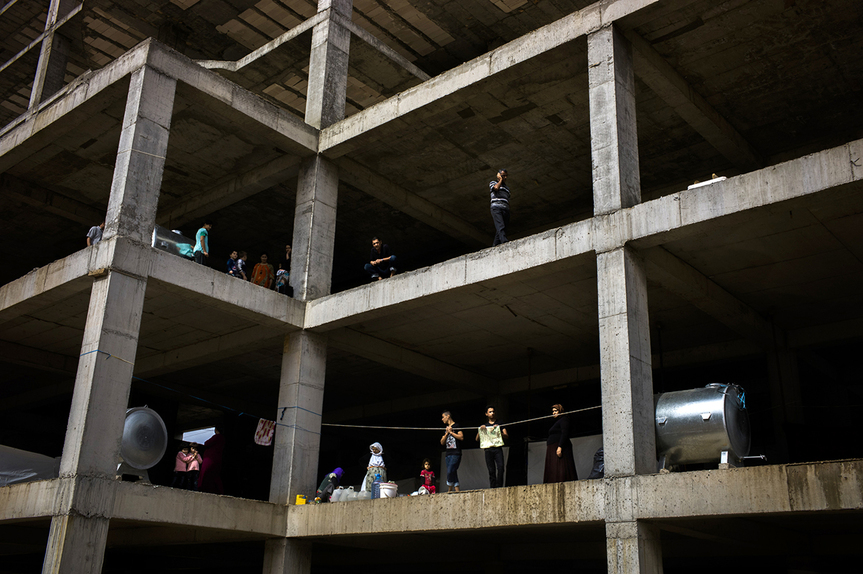
R
E
V N
E
X
T
At the Triennial of Photography Hamburg which opens today, Swiss photojournalist Dominic Nahr, whom we have featured here on this blog seven months ago, will be participating in a group exhibit titled “Refugee Perspectives” alongside two other photographers: Ayman Oghanna, who is London-born of Iraqi descent and Italian Giulio Rimondi. The focus of the exhibit will be an examination of the plight of refugees in the war-torn country of Iraq.
Nahr was in Europe when news of the atrocities committed against the religious minority, Yazidis, by the Islamic State of Iraq and Syria (ISIS) broke in August 2014. By luck he happened to be talking to someone from the United Nations High Commissioner for Refugees agency (UNHCR) and the next thing he knew he was on a plane to Erbil in northern Iraq. “It was like an omen,” he said over a recent phone conversation with me. Nahr spent the following six months on the ground primarily documenting the difficult lives of the Yazidis refugees under the protection of the UNHCR.
A member of the Kurdish religious minority, the Yazidis, of whom there are only an estimated 700,000 remaining in the world, are primarily spread over northern Iraq, where at least 200,000 Yazidis can be found with a majority of them living in the mountainous area of Sinjar. Other Yazidis populations reside in areas of southeast Turkey, northern Syria, parts of Iran and the Caucasus region. They are followers of an ancient religion derived from Zoroastrianism, with a mix of Islam (including Sufism), Christianity (including Gnosticism), Judaism, and other pre-Islamic Mesopotamian and Assyrian religious traditions. It remains a closed and secretive religion—members have to be born into the faith and cannot marry outside of it.
The Islamic State (IS) has publicly proclaimed their hatred for the Yazidis, who it deems as “devil worshippers,” and declared their intention to execute or enslave the members of this minority community. On August 3 2014, ISIS militants entered the city of Sinjar and massacred hundreds of Yazidis men. They were forced with the choice of either converting to Islam and pledge allegiance to ISIS or condemned to death, while women and children were abducted and later sold as slaves. More atrocities followed in subsequent months as ISIS attacked surrounding villages. By October 2014, the United Nations (UN) had confirmed 5000 men had been executed and 7000 women were being kept as sex slaves. Fearing for their lives, most of the surviving populations fled to the nearby mountains without food or water, and in the days that followed, many died of dehydration, exhaustion, and starvation.
According to reports by the UN, 80,000 refugees have since settled in Dohuk—a city with a population of just under 350,000 residents—and which is within a close distance of an hour and a half drive to both the Syrian and Turkish border. Hundreds of thousands of Yazidis refugees have found shelter in unfinished skeletons of buildings and construction sites, public spaces and informal settlements. Some of these incomplete structures stood up to 13 stories high, with no internal or external walls or windows, water or electricity. Dust and grit fell from the unfinished ceilings; the smell of human waste lingered due to the lack of toilets. The larger encampments have a few metal water tanks brought in by local communities, but trucks did not come to supply fresh, clean water. Most people filled their tanks with well water drawn from the ground outside their encampments. Safe drinking water was only available as packaged bottled water donated by the people of Dohuk, while kind-hearted local families dropped off food. However, such goodwill did not suffice despite good intentions. Hard months lay ahead, as the inevitable cold of the long winter came to envelope the mountains, a chill that would last until May. Without more robust shelter and other aid, the Yazidi refugees feared the inevitable. It was here in Dohuk, as well as in the surrounding cities of Daben and Dakho that Nahr began his project and would return repeatedly over the winter until the end of his stay in April 2015.
In the work that will be exhibited at the Triennial of Photography Hamburg, Nahr has consciously decided to stray from the “straight” illustrative type of wire or newspaper photography. During our conversation, Nahr offered an explanation on the differences in his approach with this project compared to his other works in the past ten years: “I felt I had more time [with this project] and it wasn’t like I was in other assignments where I had to quickly get the shots, running around like crazy. Here, I could slow down more. I wasn’t sure if this was a month long assignment, or three months, or more…[however] I was prepared to stay.”
It is incredulous to think we are living in the 21st century when news of these barbaric acts is brought to light. It is perhaps even more offensive to hear Islamic State militants publicly stating their purportedly righteousness in carrying out these murderous and horrific acts. The resulting body of work—most of them filled with a substantial amount of black and dark shadow—was a direct emotional response to the scarcity of colors Nahr saw within his chosen compositional frame. Nahr used what little light there was available in the dark environment he was in to heighten the drama and pathos he was confronted with. He wanted to bring in a more personal reading into the frame of his compositions. “ I want these images to provoke more questions from the viewer, I want them to look longer and harder.” When asked why he chose color over black and white photography, Nahr remarks, “I respond emotionally with color, while black and white may offer a truer reading of the grittiness of the situation, but I don’t respond compositionally as well in black and white as I am with color.”
Billy Kung is photo editor at ArtAsiaPacific.



